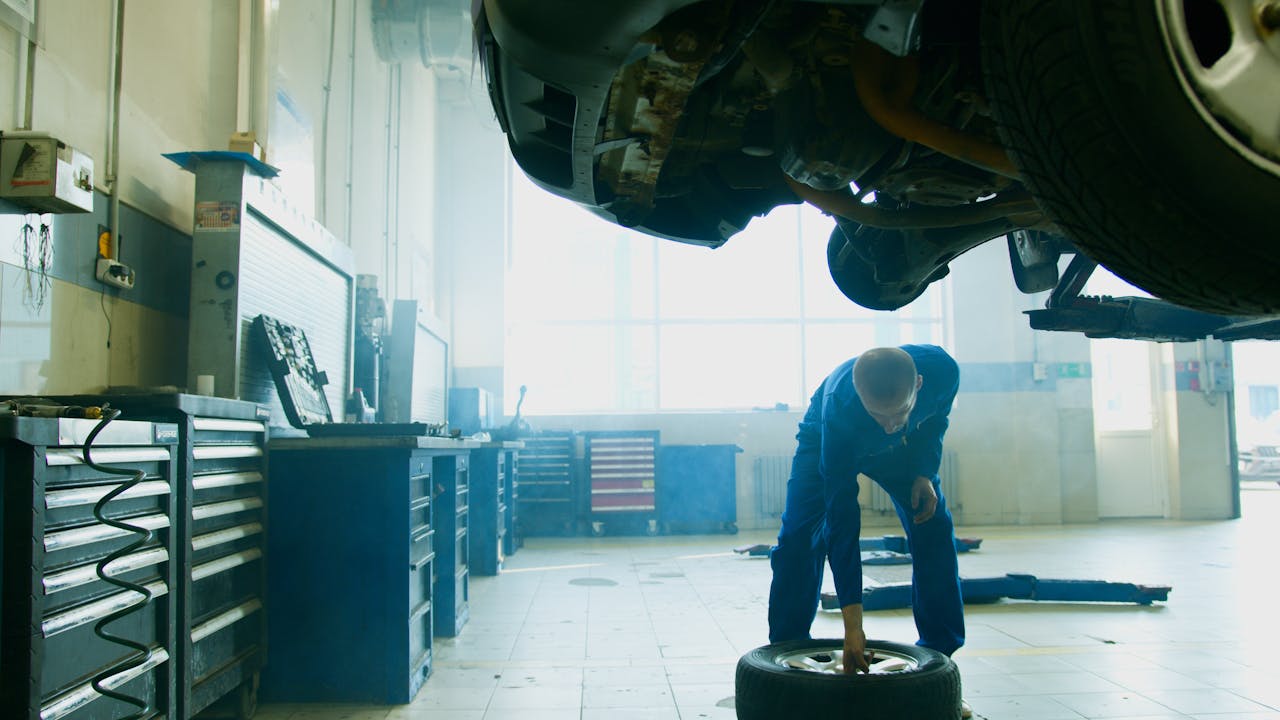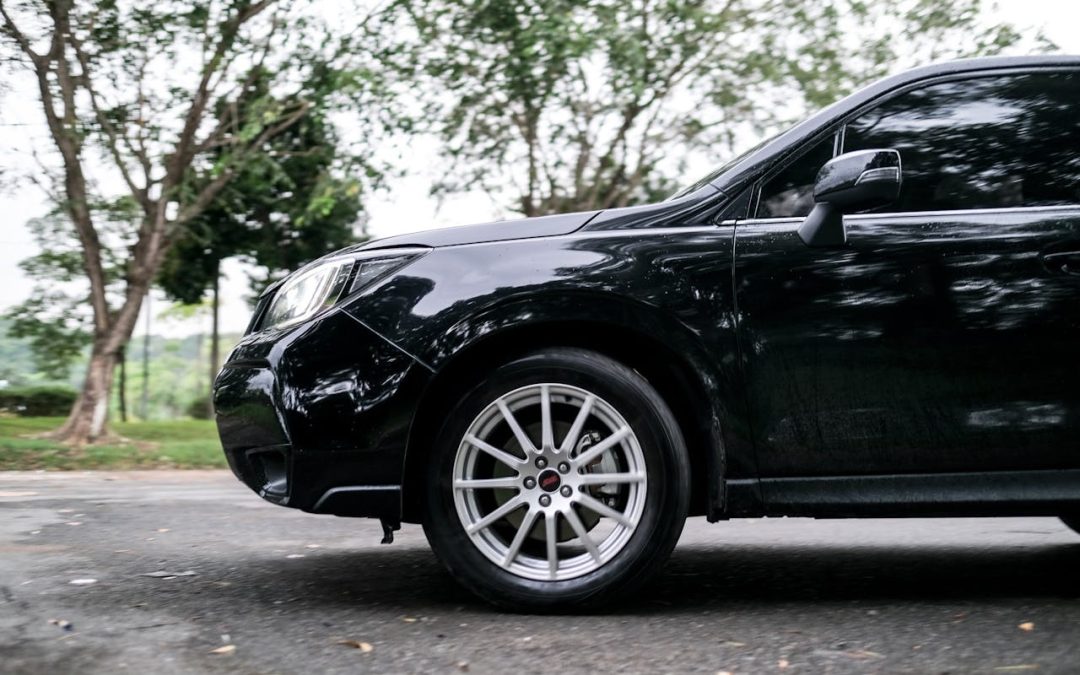Key Takeaways
- Tire balancing is the practice of equalizing the weight distribution in your tires and wheels. This process eliminates unwanted vibrations and keeps your drive smooth and comfortable. Well-balanced tires lead to the best ride, protection, and driving experience.
- Vibrations in the steering wheel, seat, or floorboard, as well as uneven tire wear, are clear indicators that your tires may need balancing. Catching these warning signs early prevents more extensive and expensive damage from occurring.
- Routine tire balancing—ideally done every 12,000 to 15,000 miles or once a year—maximizes tire performance and longevity. Balancing is especially important following tire mounting, repair, or when dealing with vibration issues.
- Even tire imbalance has common causes, such as manufacturing defects, impacts with potholes, and improper mounting of the tires. Properly maintaining tire balance helps avoid uneven tire wear and cuts down on strain on your vehicle’s suspension system.
- Static, dynamic, and on-car balancing. Static and dynamic balancing methods are the most common. Each fits different applications. Among the common methods, dynamic balancing is the most efficient for correcting the vertical and lateral imbalances, which are essential for high-speed driving.
- Tire balancing and wheel alignment are different but related services. While tire balancing addresses weight distribution, tire alignment addresses the angle of your wheels. Both are crucial for smooth rides and safe vehicle operation.
Tire balancing is the process of equally distributing weight around a tire and wheel assembly to help guarantee smooth, even rotation. In simple terms, you add little weights to the wheel assembly to balance out any uneven distribution of weight.
These imbalances may result from manufacturing defects or deterioration over time. If your tires aren’t properly balanced, you’ll likely experience one or more of the following issues:
- Uneven tire wear
- Vibrations in the steering wheel
- Poor gas mileage
The whole process is based around highly precise tools, like a balancing machine, that find imbalances down to the ounces. These corrections improve ride quality while increasing the life of the vehicle.
Knowing the science behind tire balancing is crucial, as it affects your vehicle’s performance, safety, and maintenance costs. In the next few sections, we’ll cover the science behind tire balancing, its advantages, and how often you should get it done.
What Is Tire Balancing?
Tire balancing is the act of uniformly redistributing the weight of a tire and wheel combination so it travels smoothly. A poorly balanced tire will produce obvious vibrations. These vibrations, which are magnified at higher speeds, damage ride comfort and overall vehicle control.
Tire balancing is an effective way to neutralize imbalances. Doing so makes for a smoother ride, and it protects your car’s parts from premature damage.
Define Tire Balancing
Tire balancing may be the most basic, yet most overlooked, maintenance and repair task for vehicle owners. This process requires specialized equipment to determine where there is an uneven distribution of weight in the tire and wheel assembly.
To illustrate, static balancers only care about getting the center of mass to match up with the wheel’s axis of rotation. Dynamic balancers mimic actual on-road driving to identify and correct imbalance in multiple longitudinal powertrain planes.
Properly balanced tires improve handling, reduce road noise, and help provide a more comfortable ride.
Why Balancing Matters
Inadequately balanced tires can cause damaging vibrations that make driving a bumpy ride and make your vehicle less safe to drive. In addition to comfort, tire balancing helps avoid uneven tread wear, which can shorten tire life and decrease traction if not addressed.
Correct balance saves wear on suspension parts, including shocks and struts, from extra stress due to excess tire movement. Down the line, this regular wear-and-tear maintenance will save money on expensive repairs.
Physics Of Tire Imbalance
Imbalance happens because of slight weight discrepancies in the tire/wheel assembly. These imperfections cause centrifugal forces when spinning that lead to vibration.
Left unchecked, these forces can negatively impact ride handling, stability, and vehicle safety as a whole.
Why Balance Tires And Wheels?
Proper tire balancing is key to maximizing your vehicle’s performance, safety, and comfort. Eventually, even minor imperfections in the mass distribution of a tire and wheel assembly can cause imbalance. Simple activities like everyday wear and tear, hitting a pothole, or running into a curb can all contribute to this problem.
If left uncorrected, unbalanced tires can cause vibrations, uneven tread wear, and premature wear on your vehicle’s components.
Improve Driving Comfort
Balanced tires are essential in eliminating harmful vibrations, providing the safest and most comfortable ride. If they’re not balanced, a vibration may occur at certain speeds due to uneven weight distribution. That can certainly spoil employees’ enjoyment of travel on longer trips.
For travelers, that means less travel stress and discomfort, and a better overall experience. For example, a balanced tire avoids the “wobble” effect, especially noticeable on highways, which not only impacts comfort but also driving satisfaction.
Enhance Vehicle Safety
Tires that are not balanced will have an impact on ride quality and handling. Poor balance makes a vehicle much harder to control, particularly during emergency maneuvers, such as sudden stops or sharp turns. Furthermore, having balanced tires promotes even traction and grip, which is essential for safety during wet or slippery weather.
Failure to achieve a proper balance can result in an excessive tendency for the vehicle to skid or break unevenly. Consider the example of a vehicle equipped with badly balanced tires. It may be unable to keep itself steady at highway speeds, which can create dangerous hazards.
Extend Tire Lifespan
Balancing helps eliminate uneven tread wear, which prolongs your tires’ life expectancy. By regularly balancing tires and wheels, businesses will reduce overall replacements, resulting in significant cost savings over time.
For instance, well-balanced tires prevent excessive “cupping,” a wear pattern that reduces tire life and contributes to more waste tires. This practice has the added plus of saving the environment by creating less waste.
How Do Wheels Become Unbalanced?
Tire imbalance happens when a wheel’s weight distribution is not uniform around the tire. There are a few reasons that something might throw your tires out of balance. These disturbances may manifest themselves in easily perceived symptoms such as vibrations and irregular tire wear.
Manufacturing Imperfections
As a corollary, even when they are produced, no two tires or wheels are the same. Tiny variations in material density or minor deviations in production can lead to weight imbalances. For example, a tire might have a denser patch of rubber.
At the same time, one wheel might be milled in such a way that the metal casting is a little bit different. This is where quality control is very important, but even new tires can come with a bit of imbalance.
This is why balancing is important, even with newly mounted tires, to deliver the best performance possible.
Road Impacts And Wear
Even driving around in day-to-day scenarios can play a major role in tire imbalance. Impact from potholes, curb rubs, or uneven road surfaces can cause an imbalance in the overall weight distribution of your tire and wheels.
Over time, normal wear and tear, like uneven tread wear, makes the issue even worse. Environmental changes, such as ice or snow accumulating in wheel wells, can cause a temporary imbalance.
Drivers who regularly travel on bad roads or in severe climates are at higher risk for these problems.
Tire Mounting Issues
Improper mounting when tires are installed can be a major contributor to imbalance. When a tire is not properly seated on the rim, there may be a development of an uneven weight distribution.
These mistakes can be avoided by professional installation, where trained technicians with precise tools align and balance your tires just right. Editorial accidents, like failure to remove any debris from the wheel mounting surface, can create significant issues over time.

Signs Your Tires Need Balancing
Tire imbalance can be a serious detriment to your driving experience, as well as an expense for unnecessary wear and deterioration. Spotting the signs of an unbalanced tire early can preserve peak performance, functionality, and safety on the go, while avoiding costly damages and repairs later on. Below are important signs and what they affect.
Steering Wheel Vibration
One of the most obvious signs of tire imbalance is steering wheel vibration. This is commonly caused by uneven weight distribution in your tires, which is usually only felt dramatically at faster speeds, when you start seeing your hands shake on the steering wheel at highway speeds, which indicates a problem.
This makes it the perfect time to keep an eye on your tire balance. Not addressing this can cause excess strain on suspension components, creating a snowball effect and worsening the issue as time goes on.
Seat Or Floorboard Vibration
It’s not just steering wheel vibrations that indicate an imbalance. When tires are out of balance, they’re often most noticeable in the seat or floorboard. This can make even long occasions to travel uncomfortable and distracting for the operator.
Everyday scenarios, such as driving over potholes or curbs, can quickly cause imbalances. Learning to recognize these feelings is the key to protecting your balance.
Uneven Tire Wear
When your tires are imbalanced, they will wear unevenly, which can be detected in a tread pattern that looks irregular or develops too quickly. Check your tires regularly for any signs of uneven wear, which can both shorten tire life and impact their grip on the road.
Regular tire balancing, combined with rotations every 5,000 to 6,000 miles, helps prevent this issue and keeps your tires performing as intended.
Ride Quality Decline
A bouncy, jittery, less comfortable journey is a clear sign of an imbalance. Today’s vehicles are engineered to high levels of precision, and tiny imbalances can have a tremendous effect on ride comfort and quality.
When you start to experience these warning signs of unbalanced tires, make tire balancing a priority to return your ride to its smooth and safe performance.
How Often Should You Balance Tires?
Routine tire balancing is vital to guaranteeing a comfortable ride, prolonging tire life, and maintaining peak vehicle operation. Mileage, time, tire wear, and brand all play a part in how often tires need balancing.
Mileage-Based Recommendations
Tire balancing should be done pretty much every 12,000 to 15,000 miles to fix uneven weight distribution due to normal wear and tear. Balancing tires every 5,000 to 8,000 miles, the same interval as tire rotation, can help prevent uneven wear from accruing over time.
Mileage directly impacts balance since tires naturally lose uniform weight distribution over time, especially during long commutes or rough road conditions. Having a clear record of your mileage helps you remember when it’s time to address any necessary maintenance.
This proactive step assists you in preventing problems that arise from ignoring balance.
Time-Based Recommendations
Regardless of how often you drive, tire balancing is an important aspect of tire maintenance, with most experts recommending a balance at least every six months to a year. Creep caused by shifts in tire material, environmental factors, or lack of vehicle use can lead to imbalances over time.
Regular maintenance keeps your tires performing their best and avoids small problems from turning into big repair bills down the road.
After Tire Replacement Or Repair
Whenever you get new tires put on, balancing and aligning your vehicle’s wheels are an important part of the tire installation procedure. These are independent from each other, but just as important to have even wear and proper handling.
Repairs such as patching up punctures can change the balance, and immediate rebalancing is necessary to recoup performance and safety.
When Experiencing Vibrations
Experiencing vibrations or bouncing while driving is a sure sign your tires need balancing. Taking care of this issue as soon as possible prevents damage to expensive suspension parts and keeps tires from wearing unevenly.
Since about 80% of tire issues are caused by poor balance, early treatment is essential.
Tire Balancing Methods
Tire balancing is the process of making sure that weight is distributed evenly around the tire and wheel assembly. This process extends tire life by preventing uneven wear, improving vehicle handling, and ride comfort. There are three primary methods: static balancing, dynamic balancing, and on-car balancing, each suited for specific scenarios.
Static Balancing Explained
Static balancing only addresses vertical imbalances. For one, you have to mount the wheel and tire assembly on a spindle or other balancing machine. This configuration allows the entire assembly to rotate independently.
The point of heaviest balance just invariably falls to the bottom, and weights are added to counterbalance it. Static balancing is most effective for minor imbalances. It’s often used on passenger vehicles and tires that are smaller, where lateral forces are less of a factor.
Although it works great for this use, it doesn’t take care of the side-to-side (lateral) problems that can start to appear at high speeds.
Dynamic Balancing Explained
Dynamic balancing corrects both vertical and lateral imbalances. Today’s high-tech dynamic balancers utilize cutting-edge, spinning computer technology to measure weight discrepancies in three axes, delivering pinpoint accuracy.
This approach is superior for vehicles regularly operated at higher speeds. It improves ride quality by minimizing vibration, achieving a more comfortable ride.
The downside to this method is that dynamic balancing usually takes longer and involves more specialized equipment. Yet, its capacity to counter serious imbalances is what renders it all-important for larger vehicles or quick-moving uses.
On-Car Balancing
On-car balancing is the process of balancing a tire while it is still mounted on the vehicle. This method takes into consideration the effects of actual conditions, such as the effect of the brake rotor and the hub assembly.
For this reason, it provides very precise outcomes. That’s performed less often as it’s more complex, requiring specialized gear, and is much moretime-intensivee.
Even with that said, on-car balancing is favored when accuracy is key, like for high-performance or specialty cars.

Tire Balancing VS. Wheel Alignment
Tire balancing and wheel alignment need to be done together, but they are two very different processes. Both are important for achieving the best ride quality and handling from your vehicle, but they focus on different characteristics of tire performance. Knowing the difference between tire balancing and wheel alignment will ensure you can make smarter choices with your vehicle’s maintenance.
Balancing Focuses On Weight
Tire balancing addresses the weight distribution around the tire-and-wheel assembly. An unbalanced tire has a heavy spot, which throws off the delicate roll of the tire. This weight imbalance leads to severe vibrations, especially at high speeds.
Correct tire balancing is essential for a smoother ride and extended suspension life, as it ensures weight is distributed across the tire evenly. When unbalanced tires wear after 5,000 to 6,000 miles, it’s largely avoidable wear. Having them balanced at these intervals greatly increases their life and handling capabilities.
Alignment Corrects Angles
Unlike tire balancing, wheel alignment works to change the angle of your wheels to ensure they align with the manufacturer’s specifications. Misaligned wheels may wear out tires unevenly, make it hard to steer, or even pull the vehicle to one side.
Left unattended, alignment problems can reduce a tire’s lifespan by thousands of miles and damage parts such as the suspension. More drivers would benefit from alignment checks every 6,000 miles. It’s advisable to get them done at least every six months for better handling and safer driving overall.
Complementary Services
While balancing and alignment serve different purposes, they work together to improve ride quality. Scheduling them together saves time and makes sure your tires are doing their job as efficiently as possible.
Consistent inspections will not only prolong tire life but improve the performance of your entire vehicle as well.
Benefits Of Proper Tire Balance
Proper tire balance is more than just keeping your vehicle running smoothly, it’s letting all areas of your driving experience flourish. From enhanced ride comfort to fuel-saving efficiency, balanced tires are an important part of what keeps your car running at its best.
Smoother Ride Experience
With a proper balance, the number one cause of vibrations and disturbances that can make driving unpleasant is greatly diminished. With bad balance, you’ll notice an ongoing vibration or jitter, perhaps more like a bobbing or swaying motion, most noticeable on the freeway.
This is in addition to the fact that it can put the passengers on board for a less comfortable ride. Imagine taking an extended road trip. With balanced tires, the ride continues to be smooth and distraction-free, so you can enjoy every journey to the fullest!
Balanced tires benefit you in a tangible way right away—no more unnecessary bumps in your driving experience.
Reduced Stress On Suspension
Imbalanced tires create excess wear and tear on suspension components, such as struts and shocks. In the long run, this can lead to expensive repairs to your suspension system.
Proper tire balance ensures that weight is evenly distributed across all tires. This motion places less stress on your whole car’s system. This preserves your suspension’s integrity, too.
In addition, proper tire balance prolongs its life, keeping your vehicle dependable for years to come.
Better Fuel Efficiency
Properly balanced tires contribute to better fuel efficiency by minimizing rolling resistance, which helps the environment and saves money. Studies have found that proper balance increases fuel economy by as much as 3%.
This improvement translates to real savings at the pump. Less rolling resistance means less strain on your engine to keep your ride running nice and smooth.
Optimized Handling
Properly balanced tires provide better steering response and stability, allowing for better control during sharp turns or evasive maneuvers. They make for safer driving in all conditions, from rain-slicked asphalt to bumpy roads over bridges or through potholes.
A well-balanced tire prevents uneven tread wear that can cause handling issues and compromise safety.
Factors Affecting Tire Balance
Tire balance is vitally important to getting the smoothest ride, minimizing vehicle wear and tear, and maximizing your vehicle’s fuel efficiency. It all depends on a variety of factors, each playing a role in how evenly the tire and wheel assembly carry weight. By keeping an eye on these factors, you can prevent issues such as vibrations, uneven tread wear, or other performance-related concerns.
Tire Design And Material
A tire’s balance is directly impacted by the design and materials used within a tire. Tires with complex tread patterns generally have more complicated weight distributions. This is particularly true for specialty tires, like all-terrain or extreme-performance tires.
Materials come into account too—synthetic rubber, steel wires, or fabric layers have to be built perfectly symmetrically. For example, an all-terrain tire might be heavier on one side because it has added, reinforced sidewalls. Selecting the right tire for your driving habits leads to improved balance and overall performance.
Road Conditions Impact
The most underrated factor affecting tire balance is everyday road conditions. Every time you hit a pothole, curb, or rough road, it moves that weight around inside the tire assembly, resulting in imbalance.
The faster tread wear is most notable with uneven roads as well. City driving with lots of impacts against the curb likely means you would need to check your balance more often. Being more mindful about driving, such as driving slower on poor roads, can reduce some of the impacts.
Temperature Fluctuations
Extreme temperature changes may change the pressure of your tires, impacting their tire balance. As one important example, cold weather tends to lower tire pressure, whereas hot conditions raise it.
Too much or too little pressure will cause balding and other uneven wear patterns and vibrations. Routine pressure checks, particularly with changing seasons, will keep pressure in check.
Conclusion
Tire balancing ensures a smooth ride, protects your tires and suspension. It ensures even wear, minimizes vibrations, and allows your car to perform at peak levels. Properly balanced tires will save you money by increasing the overall life of your tires and giving you better fuel economy.
Neglecting balance issues can result in an unnerving ride, more frequent tire replacement, or worse, an unsafe vehicle. Frequent inspections and immediate balancing when needed have a huge impact. Whether you’re feeling weird vibrations or it’s time for your regular maintenance, having your tires balanced keeps your vehicle operating as it should.
Care for your tires, and they’ll care for you. Get smart about tire balancing and ride safer and more comfortably. You, too, can experience the difference that proper tire balance makes. Connect with an experienced tire professional. Who you work with matters when it comes to maximizing the life and safety of your vehicle.
Frequently Asked Questions
1. What Is Tire Balancing?
Tire balancing is the process of making sure all the weight of a tire and wheel assembly is evenly distributed. This allows for even wear, no vibration, and superior handling while driving.
2. How Do I Know If My Tires Are Unbalanced?
Typical indicators are shaking in the steering wheel, inconsistent wear on the tires, and sudden drops in gas mileage. Routine checks can detect problems before they start.
3. How Often Should Tires Be Balanced?
Generally, tires need to be balanced every 5,000 to 6,000 miles, or with each tire rotation. Consult your vehicle owner’s manual for specific guidance.
4. Why Is Balancing Tires Important?
In addition to a more comfortable ride experience, correctly balanced tires contribute to better fuel economy and longer tire life. It additionally avoids excess stress on suspension and steering parts.
5. What Causes Tires To Become Unbalanced?
Common causes of unbalanced tires include uneven wear, hitting potholes or other debris on the road, and losing wheel weights. Keeping up with regular maintenance can go a long way in avoiding this.
6. Is Tire Balancing The Same As Wheel Alignment?
No, no, they’re not the same. Balancing smooths out the uneven distribution of tire weight. Alignment corrects the angles of the wheels so they make optimal contact with the road.
7. What Are The Benefits Of Balanced Tires?
Balanced tires deliver a smoother ride, improved fuel economy, longer tire life, and safer handling. It saves wear on your car’s suspension and steering components.
Rev Up Your Ride With Expert Car Tire Balancing!
Experience the excellence of autoTECH Blackhawk in the realm of car tire balancing. Why choose us for your vehicle’s car tire balancing needs? Our standout feature is our unwavering dedication to building strong relationships with our clients, a crucial element in the specialized field of car tire balancing. This commitment forms the cornerstone of our tailored services, ensuring our solutions align with your specific goals for safety, efficiency, and long-term tire health.
Whether you’re dealing with vibrations, uneven tread wear, steering wheel shimmy, or simply seeking expert advice on how to maintain your tires’ integrity, autoTECH Blackhawk is here to exceed your expectations. We take immense pride in our industry-leading 3-year/36,000-mile warranty and our commitment to using only high-quality, manufacturer-recommended parts and components.
Don’t hesitate to contact our friendly team today to schedule a convenient and contactless consultation for your car tire balancing needs!


